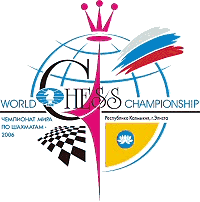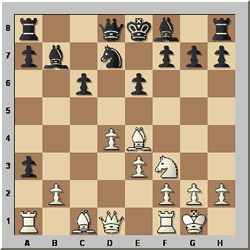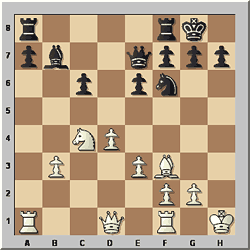



Veselin Topalov vs Vladimir Kramnik Twelve games, played from September 23 to October 12 in Elista, Kalmikia. The games start at 15:00h (3:00 p.m.) local Elista time, which translates to 11:00h GMT, 13:00h CEST, 12:00h London, 7 a.m. New York. |
 |
| Live coverage is available on the official FIDE site and on Playchess.com (with live audio commentary by GM Yasser Seirawan for ten Ducats per day). You can buy them in the ChessBase Shop. |
Veselin Topalov, having lost two games and drawn the third, was grimly determined to get back into the match with his second white game. He played a pawn sacrifice that was clearly cooked up in home preparation, forcing Kramnik in the defensive. The Classical Chess World Champion returned the pawn and traded down to a complicated ending in which Topalov tried hard to make something of his central pawn majority. The game ended after over five hours of play and 54 moves in a draw. The score is now 3-1 for Kramnik.

The players behind their glass "wall" at the start of game four

Cyrillic: Tomanob has white, Kpamhnk has black

Topalov pushing Kramnik in the defensive in his second white game
The following express commentary was provided to us by Romanian GM Mihail Marin, who is the author of a number of very popular ChessBase training CDs and articles for ChessBase Magazine. GM Marin will study the game from the World Championship in Elista in greater detail and provide the results of his analysis in the next issue of ChessBase Magazine. Note that there is a replay link at the end of the game. Clicking this will produce a (separate) JavaScript replay window, where you have replay buttons but can also click on the notation to follow the moves.
Topalov,V (2813) - Kramnik,V (2743) [D47]
WCh Elista RUS (4), 27.09.2006 [Mihail Marin]
1.d4 d5 2.c4 c6 3.Nc3 Nf6 4.e3. After four games, we can notice a certain pattern in the players' match strategy. Kramnik sticks to the openings that enabled him take the lead (the Catalan with the black pieces and the Slav with Black), while Topalov deviates at a very early stage. Their attitude must have some psychological implications, because logically it is only Topalov who can be content about the outcome of the opening in the first two games. 4...e6 5.Nf3 Nbd7 6.Bd3 dxc4 7.Bxc4 b5 8.Bd3 Bb7 9.a3. In the main lines starting with 9.0-0 or 9.e4 White has generally faced problems proving an advantage. By choosing a relatively unexplored line, Topalov shows that he does not intend to question Kramnik's famously accurate preparation and that he prefers to move the accent of the fight on the middlegame. This might be a reason why in the second game he refrained from his habitual 6.Ne5. 9...b4 10.Ne4 Nxe4 11.Bxe4.

Veselin Topalov vs Vladimir Kramnik, game four after 11.Bxe4
11...bxa3 12.0-0.



26...Rb8 27.Qd1 Be4 28.Qa1 Rb7 29.Nd2 Bg6 30.Qc3 h6 31.Ra6 Kh7 32.Nc4 Be4 33.f3 Bd5 34.Nd2 Rdb8 35.Qd3+ f5. Finally, White has managed to induce a small weakness in the enemy structure, but this is a price Black is ready to pay for the stability of his centralized bishop. 36.Rc3. White will now try to occupy the centre with e4, which would offer him an advantage, but Black will defend very accurately. 36...Qh4 37.Ra1 Qg3 38.Qc2 Rf7 39.Rf1 Qg6 40.Qd3 Qg3 41.Rfc1 Rfb7 42.Qc2 Qg5 43.Ra1. One of the nicest hidden lines from this phase is 43.e4? Bxb3! when the c1-rook would be hanging. 43...Qf6 44.Qd3 Rd7 45.Ra4 Rbd8 46.Rc5 Kg8 47.Nc4 Bxc4 48.Raxc4 f4. White cannot avoid complete the complete simplification of the position now. 49.Rc6 fxe3 50.Qxe3 Rxd4 51.Rxe6 Qh4 52.Rxd4 Qxd4 53.Re8+ Kh7 54.Qxd4. Even according to the Sofia rule the position should be considered a dead draw. 1/2-1/2. [Click to replay]

Veselin Topalov, still waiting for a first win in this match
| Player |
|
|
|
|
|
|
|
|
|
|
|
|
|
|
|
| Veselin Topalov | |
|
|
|
|
|
|||||||||
| Vladimir Kramnik | |
|
|
|
|